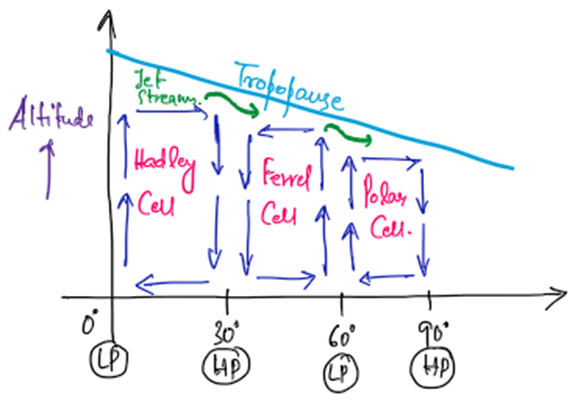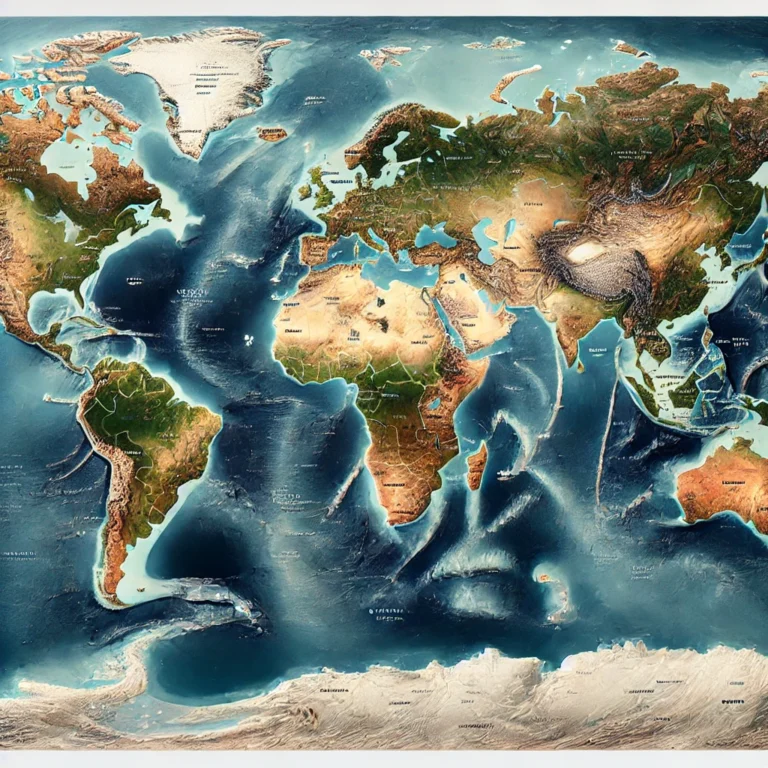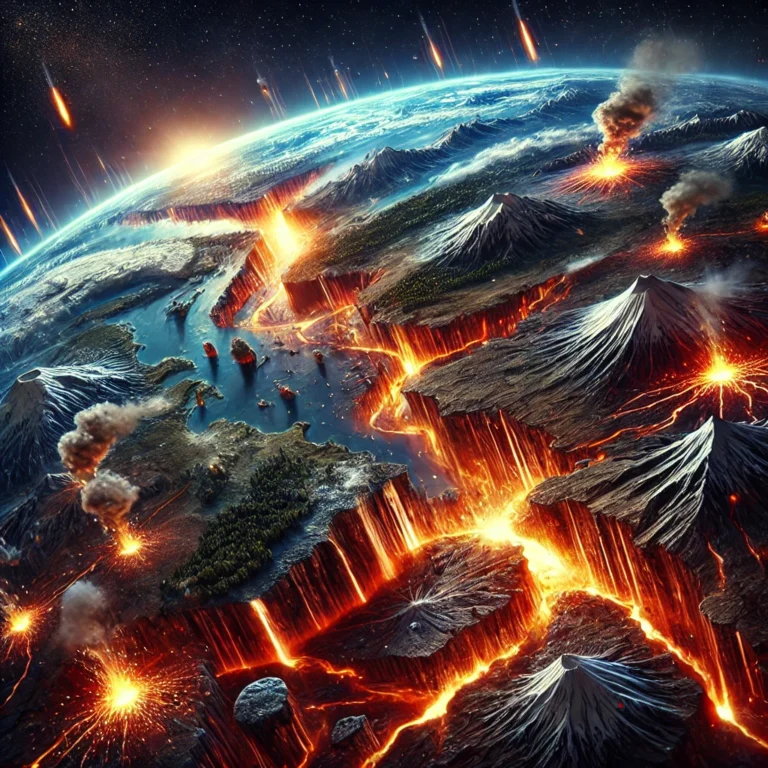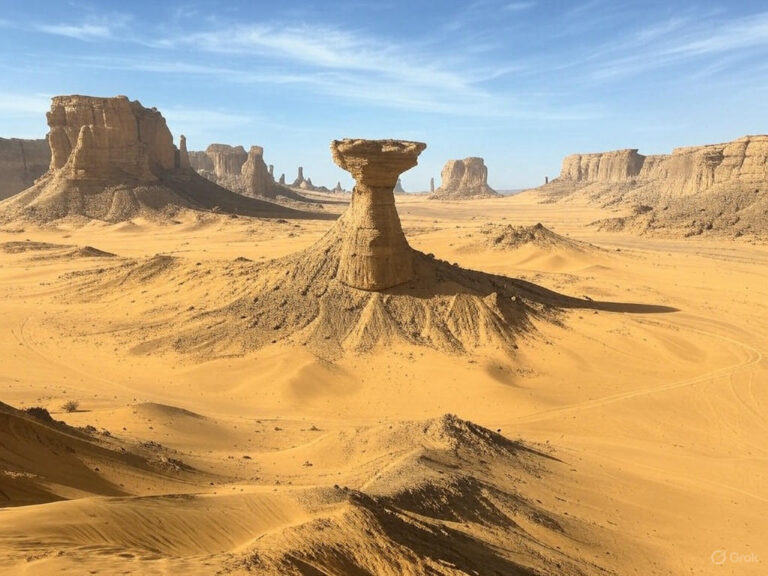General Atmospheric Circulation 🌍🌬️
Imagine Earth as a giant atmospheric machine, constantly moving air around due to pressure differences. This movement, from local breezes to global wind patterns, follows daily, seasonal, and annual cycles. It is shaped by multiple factors, including Earth’s rotation, heat imbalance, and gravitational forces.
Atmospheric circulation means movement of air due to pressure gradient from local to global levels and from daily to seasonal and annual pattern over the earth’s surface. It is thus apparent that the atmospheric circulation has spatial, temporal and altitudinal components.
Types of Atmospheric Circulation
1. Based on Time (Temporal Division)
- Primary Circulation: Global-scale movements like planetary winds (Trade Winds, Westerlies, Polar Easterlies).
- Seasonal Circulation: Large-scale variations, such as monsoons.
- Diurnal Circulation: Daily patterns like land and sea breezes.
2. Based on Space (Spatial Division)
- General (Primary) Circulation: Large-scale global wind systems responsible for distributing heat and moisture.
- Secondary Circulation: Includes cyclones, anticyclones, and jet streams, which modify primary circulation.
- Tertiary Circulation: Local wind systems like Harmattan (Africa), Chinook (North America), and Mistral (Europe).

General Circulation
Also known as primary circulation, this global wind system is crucial for weather and climate because:
- Heat Transfer: It moves heat from low latitudes (equator) to high latitudes (poles), balancing Earth’s temperature.
- Moisture Transport: It carries moisture from oceans to continents, influencing rainfall, cloud formation, and the hydrological cycle.
Why Does General Circulation Occur?
The main cause is the uneven heating of Earth—equatorial regions receive more solar energy than the poles. Additional influences include:
- Earth’s Rotation (Coriolis Effect): Causes winds to curve rather than move in a straight line.
- Gravity: Helps in maintaining atmospheric stability.
Models of General Circulation
There are multiple theories explaining how Earth’s atmospheric circulation works, each refining our understanding of global wind patterns and climate systems.
This circulation system is a key driver of global climate, affecting monsoons, ocean currents, and weather patterns worldwide! 🌎
Unicellular Circulation Model (Thermal Circulation Model) 🌍♨️❄️
Imagine a simplified Earth, where the entire surface is flat and covered only by land—no mountains, no oceans, and no valleys. In this hypothetical scenario, the Earth’s surface would heat up and cool down uniformly, unlike the real world where land and water create variations in temperature and pressure.

How Would Winds Move in This Model?
- Unequal Heating:
- Equatorial regions receive more solar energy, causing intense heating.
- Polar regions remain cold, with air sinking due to high density.
- Pressure Gradient:
- Warm air rises over the equator, creating a low-pressure zone.
- Cold, dense air sinks at the poles, forming a high-pressure zone.
- Air moves horizontally from high pressure (poles) to low pressure (equator).
- Formation of a Single Circulation Cell:
- Rising equatorial air moves toward the poles at high altitudes.
- At the poles, the air cools, sinks, and flows back toward the equator at the surface.
- This creates one large convection cell in each hemisphere, known as unicellular circulation.
Hadley’s Unicellular Circulation Model (1735) 🌍💨
George Hadley modified the thermal circulation model by incorporating Earth’s rotation and the Coriolis effect. His model still had a single large convective cell in each hemisphere, but the winds did not move directly north-south as in the earlier unicellular model.
Key Features of Hadley’s Model
- Incorporates Earth’s Rotation:
- Unlike the pure thermal circulation model, Hadley’s model accounts for the Coriolis force, which deflects winds due to Earth’s rotation.
- Formation of Hadley Cells:
- Warm air rises at the equator (low pressure) and moves toward the poles at high altitudes.
- As it moves poleward, the Coriolis effect deflects it.
- The air cools and sinks at around 30° latitude, creating high pressure zones.
- The sinking air returns toward the equator, completing a convective loop called the Hadley Cell.
- Effect on Wind Directions:
- In the Northern Hemisphere, air moving from the North Pole to the equator is deflected to the right, creating northeasterly winds (Trade Winds).
- In the Southern Hemisphere, air moving from the South Pole to the equator is deflected to the left, resulting in southeasterly winds.
Ferrel’s Tricellular Model of Atmospheric Circulation 🌍💨
Unlike the older temperature-based circulation models, the modern three-cell model explains air circulation based on both temperature gradients and dynamic forces. This model proposes that each hemisphere has three distinct air circulation cells:

1️⃣ Hadley Cell (0°–30°)
- Warm air rises at the equator due to intense heating, reaching 8–12 km in height.
- The rising air diverges poleward at high altitudes.
- Some of this air descends near 30°–35° latitudes, forming the subtropical high-pressure belt.
- The descending air returns to the equator as Trade Winds, forming a complete convective loop.
👉 This explains the Trade Winds and why hot deserts (e.g., Sahara, Thar) are found near 30° latitudes.
2️⃣ Ferrel Cell (30°–60°)
- Westerlies blow from the subtropical high-pressure belt (30°–35°) to the subpolar low-pressure belt (60°–65°).
- Warm westerlies rise near 60°–65° latitudes and diverge poleward and equatorward at high altitudes.
- The equatorward upper winds descend again near 30°–35° latitudes, reinforcing the subtropical high-pressure belt.
- Unlike the Hadley Cell, Ferrel Cell is driven by mid-latitude cyclones & anticyclones rather than direct heating.
👉 Explains westerlies in mid-latitudes and frequent temperate cyclones in this zone.
3️⃣ Polar Cell (60°–90°)
- Cold, dense air from the polar high-pressure zones moves toward 60°–65° latitudes as polar easterlies.
- At the polar front (60°–65°), cold polar air meets warm westerlies, forming temperate cyclones.
- Rising air at subpolar low-pressure zones diverges at high altitudes.
- Some of this air moves poleward and descends at the poles, reinforcing the polar high-pressure system.
👉 Explains polar easterlies, polar vortex, and formation of temperate cyclones.








One Comment